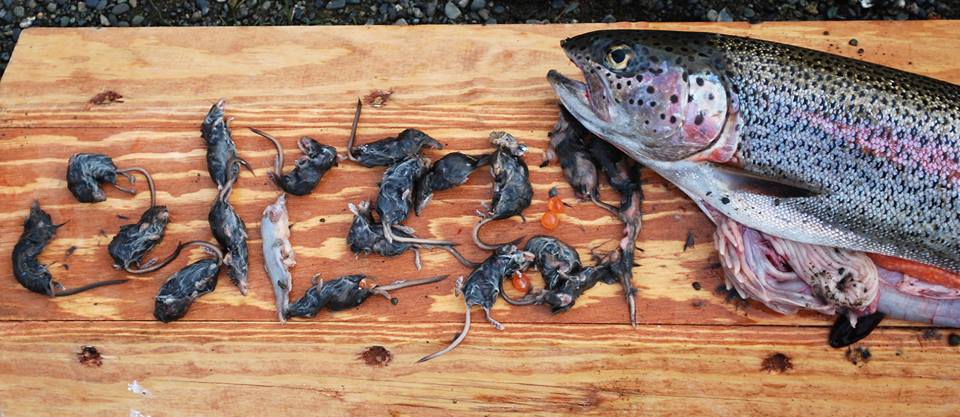Small Trout Devours Nearly 20 Shrews

If fish had competitive eating championships, a small rainbow trout in Alaska might hold a record in the "shrew" category.
Researchers recently opened up a rainbow trout in Alaska's Togiak National Wildlife Refuge, and were surprised to find the fish had eaten nearly 20 shrews, a mouse-size mammal.
To make matters stranger, the fish was relatively small, measuring only 19 inches (48 centimeters) long, said Mark Lisac, a fish biologist at Togiak National Wildlife Refuge in Alaska.
That's " an awful lot for one fish to put down," Lisac told LiveScience. That said, rainbows and related fish species have been known to eat shrews and other small mammals, including rodents, and many species of freshwater fish are opportunistic feeders that will chow down on a wide variety of prey, he said.
This rainbow trout report trumps the previous record of seven shrews eaten (at least that Lisac is aware of), which was held by a grayling, another species of fish that "keys in on shrews even more" than rainbows, Lisac said. [Photos: The Freakiest-Looking Fish]
But how did the rainbow end up with such a large shrew meal?
Shrews aren't very good swimmers and sometimes drown if they end up in water, Lisac said. "My best guess is that the shrews were on an island [or river bank] that flooded, and the rainbow happened to be in the right spot at the right time," he said.
Get the world’s most fascinating discoveries delivered straight to your inbox.
The fish feed heavily in the summer to prepare themselves for the winter, when they remain sedentary and don't eat much at all. Related species have been shown to enlarge their digestive tracts during the summer, and to digest the excess intestines in the winter, Lisac said. Rainbows may be able to do the same, he added.
Trent Sutton, a fisheries biologist at the University of Alaska Fairbanks who wasn't involved in the research, said he hadn't heard of rainbow trout eating shrews but that it doesn't surprise him since they are opportunistic predators. "Top predators, like trout, have large distensible stomachs that allow them to consume large prey items or a lot of smaller items," Sutton told LiveScience. "I do not know why there would be a lot of shrews where a trout could access them though."
More typical foods for rainbows include salmon eggs, insects and smaller fish, though they have been known to eat voles and other rodents, besides shrews (which aren't rodents).
But the fact that a rainbow would eat shrews isn't that surprising. Fly fishermen in the area are well aware of the tendency, and use special flies that mimic swimming rodents or drowning shrews, Lisac said.
If you "use a mouse fly and drag it along the surface, it seems pretty irresistible" to a variety of fish, Lisac said. Doing so can lead fish to hit the fly, but not necessarily to sink their teeth in. "They hit it and you may not catch them, but they seem to want to drown it," he said.
Species known to eat shrews and rodents also include lake trout and pike, he said.
The study that turned up the shrew-eating marvel took place on the Kanektok River in August 2009 and was primarily geared toward placing radio transmitters on 200 of the bigger fish to understand their migrations and movements. The study determined that the river consists of several different populations, meaning the various groups may need to be managed separately, as opposed to being treated as one entity, Lisac said.
Email Douglas Main or follow him on Twitter or Google+. Follow us @livescience, Facebook or Google+. Article originally on LiveScience.


